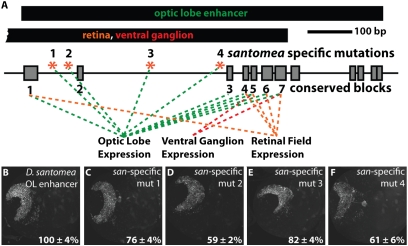Fig. 4.
Optic lobe enhancer activity depends on a variety of ancestrally conserved and newly derived inputs. (A) Schematic of the D. santomea optic lobe enhancer and the region in which it overlaps with enhancers active in the retinal field and ventral ganglion. Gray boxes depict regions that are conserved between D. santomea and species of the D. melanogaster clade (SI Appendix, Fig. S10). The position of each D. santomea-specific mutation is indicated by a red asterisk. Colored lines indicate that mutation of the indicated block or D. santomea-specific mutation had a measurable effect on the enhancer activity to which the line is connected. (B–F) Comparison of D. santomea optic lobe enhancers in which D. santomea-specific substitutions were reverted. (B) Activity of the WT D. santomea optic lobe enhancer. (E and F) Compared with the WT D. santomea construct (100 ± 4% SEM), each mutant construct displayed significantly (P < 0.005, t test) reduced activity.

